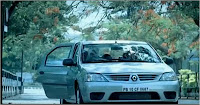Brand: Mahindra e2o
Company: Mahindra Rise
Brand Analysis Count: # 576
After the buying the Reva company from Chetan Maini in 2010, Mahindra tried to infuse the much-needed expertise and capital into the electric car company.One of the first things that Mahindra did was to rebrand the Reva cars to e2o.
The first e20 was launched in 2013 replacing the two door Reva car. The auto world was looking for some kind of revolution in the electric car segment when Mahindra took over the Reva company. But alas the status quo remains even today.
In 2016, the company retired the two door e2o and launched the four-door hatch branded as e2o plus. The change reflected the lukewarm response to the two-door car.e2o plus is a standard electric hatchback which looks more like a normal car where the earlier Reva and e2o looked more like a toy car. The company feels that the changes will fuel more consumer interest and adoption.
But odds are stacked against the electric car as of now in India. Despite the higher fuel cost and increased emissions, the government has not looked at making the electric vehicle market - its priority. The infrastructure for EV like charging stations are not existing in India. However, the silver lining is the stated objective of the Indian government to have 100% EV nation by 2030. Moreover, the government also plan to fund 60% of R&D expenses in this field to reduce the cost of technology.
So in one way, the path looks bright but the current market and marketing condition for e2o plus looks bleak. The price is the villain. The brand is priced between 6.3 lakh to 10lakh and there is a huge replacement cost of around Rs 3 lakh for the battery in 5 years. Although the cost of running the car is dirt cheap, the cost of ownership together with the battery replacement cost makes the car unviable purchase for a normal buyer.
e2o Plus is positioned as a city car. The brand is banking on the low running cost, non-polluting nature as the USPs.
Even if a consumer is genuinely interested in buying this car, the economics never works out in favor. The only way forward is to hope that the government will lend a hand in helping to reduce the cost of the car. There are other innovative business models that have emerged around the EV ecosystem. Notable is the Bangalore-based Lithium Urban-Tech which provides EV based transporting solutions to companies which will help firms reduced their carbon footprints. There are also reports of Ola creating a fleet of EV taxis. These emerging models will probably act as critical lifeline support for this category as a whole.
However, a breakthrough in the battery technology is going to be the savior for EV's future globally.
Related Brand
Reva
Company: Mahindra Rise
Brand Analysis Count: # 576
After the buying the Reva company from Chetan Maini in 2010, Mahindra tried to infuse the much-needed expertise and capital into the electric car company.One of the first things that Mahindra did was to rebrand the Reva cars to e2o.
The first e20 was launched in 2013 replacing the two door Reva car. The auto world was looking for some kind of revolution in the electric car segment when Mahindra took over the Reva company. But alas the status quo remains even today.
In 2016, the company retired the two door e2o and launched the four-door hatch branded as e2o plus. The change reflected the lukewarm response to the two-door car.e2o plus is a standard electric hatchback which looks more like a normal car where the earlier Reva and e2o looked more like a toy car. The company feels that the changes will fuel more consumer interest and adoption.
But odds are stacked against the electric car as of now in India. Despite the higher fuel cost and increased emissions, the government has not looked at making the electric vehicle market - its priority. The infrastructure for EV like charging stations are not existing in India. However, the silver lining is the stated objective of the Indian government to have 100% EV nation by 2030. Moreover, the government also plan to fund 60% of R&D expenses in this field to reduce the cost of technology.
So in one way, the path looks bright but the current market and marketing condition for e2o plus looks bleak. The price is the villain. The brand is priced between 6.3 lakh to 10lakh and there is a huge replacement cost of around Rs 3 lakh for the battery in 5 years. Although the cost of running the car is dirt cheap, the cost of ownership together with the battery replacement cost makes the car unviable purchase for a normal buyer.
e2o Plus is positioned as a city car. The brand is banking on the low running cost, non-polluting nature as the USPs.
Even if a consumer is genuinely interested in buying this car, the economics never works out in favor. The only way forward is to hope that the government will lend a hand in helping to reduce the cost of the car. There are other innovative business models that have emerged around the EV ecosystem. Notable is the Bangalore-based Lithium Urban-Tech which provides EV based transporting solutions to companies which will help firms reduced their carbon footprints. There are also reports of Ola creating a fleet of EV taxis. These emerging models will probably act as critical lifeline support for this category as a whole.
However, a breakthrough in the battery technology is going to be the savior for EV's future globally.
Related Brand
Reva









